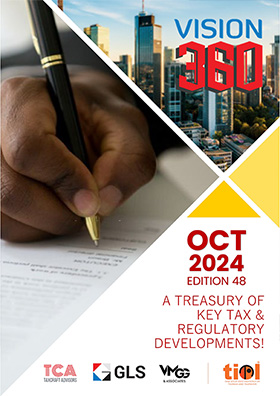I-T - Whether assessee has case even if he pays higher stamp duty as per valuation of stamp authority and claims lower capital gains as per report of approved valuer - YES: HC
By TIOL News Service
ALLAHABAD, SEPT 19, 2013: THE issues before the Bench are - Whether assessee has a case even if he pays higher stamp duty as per valuation of stamp authority and claims lower capital gains as per report of approved valuer; Whether valuation by stamp authority is not expected to have any nexus with the market value; Whether valuation under I-T Act is required to take into account attributes like occupancy by tenants, legal encumbrances and other charges; Whether if the value assessed by the stamp valuation authority exceeds u.s 50C, the AO can refer the case to the DVO and Whether if the AO relies on the report of the approved valuer u/s 55A, it is required to apply his mind and record reasons for the same. And the law point goes in favour of the assessee.
Facts of the case
In assessment proceeding assessee disclosed sale of a capital asset at Rs. 25 lacs for which he also submitted a report from approved valuer. Revenue asserted that purchaser paid stamp duty on the valuation of property as per Stamp Valuation authority and the capital gain was worked out on the basis of valuation fixed u/s 50C(2). Assessee filed objections and requested to accept the valuation shown by him on the ground that the building was under tenancy. AO rejected the claim of assessee and held that the value adopted by the stamp duty authority has to be taken as fair market value and accordingly computed the long term capital gain.
Before CIT (A) assessee submitted another valuation report suggesting that the actual distress sale value of the property was Rs. 17.30 lacs as against the valuation of the property inclusive of land and building at Rs 33.77 lacs. The CIT (A) rejected the said valuation report as it was not submitted before AO. Applying section 50C, CIT (A) held that it was mandatory on the part of AO to make reference to Valuation Officer as per provisions of section 50C where assessee contended that valuation as done by Stamp Valuation Authority was not acceptable to him. AO was not correct where he held that reference to Valuation officer was optional since assessee had not objected to value adopted by the State Valuation Authority. Clauses (a) & (b) of sub-section (2) of section 50C are continuation to each other and therefore, conditions laid down in both the clauses are required to be satisfied together-AO has to refer the valuation to the DVO for determing the fair market value if the property under transfer is less than valuation made by the State Valuation Authority. Thus, the stand taken by AO is not correct since he should have referred the matter in assessment to the DVO as in the present case, both the ingredients of provisions of section 50C(2) are present which compels the AO to refer such matter for valuation by DVO in accordance with provisions of section 55A of the I.T. Act, 1961. Thus, the valuation as per the report of approved valuer should be taken as sale consideration. Moreover the property was very old and under tenancy since 1969 fetching a nominal rent of Rs.625 per month (approx.), in the year of sale and since the assessee could not vacate the property even after a legal battle, had to sell the property to the son of the tenant.
ITAT held that provisions of Section 50 C (2) of the Act are essentially be read in conjunction with the provisions of Section 50C (1) of the Act, and the value of capital asset as determined by the approved valuer has to be taken as the sale consideration and similarly the value taken by the approved valuer as at 1.4.1981 has to be taken into consideration for the purposes of arriving at indexed cost of acquisition. ITAT did not find any infirmity in the order of CIT (A) and dismissed the appeal filed by the revenue.
After hearing both the parties, the ITAT held that,
++ Section 50C is a rule of evidence in assessing the valuation of property for calculating the capital gain. The deeming provision under Section 50 C (1) of the Act is rebuttable. It is well known that an immovable property may have various attributes, charges, encumbrances, limitations and conditions. The property was under the tenancy of father of the purchaser since 1969 and thus the assessee being landlord of the property, offered it for sale to the tenant, which could not have attracted fair market value, as a willing purchaser may have offered for a property in vacant condition. The Stamp Valuation Authority does not take into consideration the attributes of the property for determining the fair market value in the condition the property is a offered for sale and is purchased. He is required to value the property in accordance with the circle rates fixed by the Collector. The object of the valuation by the Stamp Valuation Authority is to secure revenue on such sale and not to determine the true, correct and fair market value on which it may be purchased by a willing purchaser subject to and taking into consideration its situation, condition and other attributes such as it occupation by tenant, any charge or legal encumbrances;
++ there may be several reasons for the purchaser not to file such objection. A purchaser may not go into litigation, and pay stamp duty, as fixed by the Stamp Valuation Authority, which may be over and above the fair market value of the property, as on the date of transfer, though the amount so determined has not been actually received by owner of the property. Whenever the assessee claims before AO that the value adopted or assessed or assessable by the Stamp Valuation Authority u/s 50C exceeds, AO may refer the valuation of the capital asset to a DVO. In case of any such claim, AO may rely on the report of registered valuer u/s 55-A and in such case it will not be necessary for him to refer the matter to the DVO. However, the AO has to record sufficient reasons. He has to record reasons for accepting the report of the approved valuer submitted by the assessee along with his claim/objection u/s 50C (2). If he does not accept the report, he has to record the reason for referring the matter to the DVO which must have nexus with the objection/claim made by the assessee;
++ CIT (A) has correctly observed in his order that the provisions of Section 50C (2) are essentially to be read in conjunction with the provisions of Section 50C (1). It was necessary for the AO to refer the matter for valuation to DVO in accordance with provisions of Section 55-A. ITAT failed to consider that AO did not record any finding either on the validity of the claim/objection filed by the assessee nor did he record any finding on the sufficiency of valuation of the approved valuer submitted by the assessee;
++ assessee submitted three different valuation reports of the approved valuer. The first report was based on the valuation as on 1.4.1981, the second report was based on the valuation as on October 2004 and the third report was based on distress sale value of the property. The third valuation report was prepared during the proceedings before AO. The assessee submitted the said third report before CIT (A) as additional evidence which was rejected by the CIT (A);
++ whenever objection is taken or claim is made before AO, that the value adopted or assessed or assessable by the Stamp Valuation Authority under sub-section (1) of Section 50-C exceeds the fair market value of the property on the date of transfer, the AO has to apply his mind on the validity of the objection of the assessee. He may either accept the valuation of the property on the basis of the report of the approved valuer filed by the assessee, or invite objection from the department and refer the question of valuation of the capital asset to DVO in accordance with Section 55-A of the Act. In all these events, AO has to record valid reasons, which are justifiable in law. He is not required to adopt an evasive approach of applying deeming provision without deciding the objection or to refer the matter to the DVO u/s 55-A of the Act as a matter of course, without considering the report of approved valuer submitted by assessee. In all such cases, the reasons recorded by the AO may be questioned by the assessee or the department as the case may be. Matter is remanded to AO, to decide the valuation of the capital asset in accordance with law as explained in this judgement.
(See 2013-TIOL-704-HC-ALL-IT)














